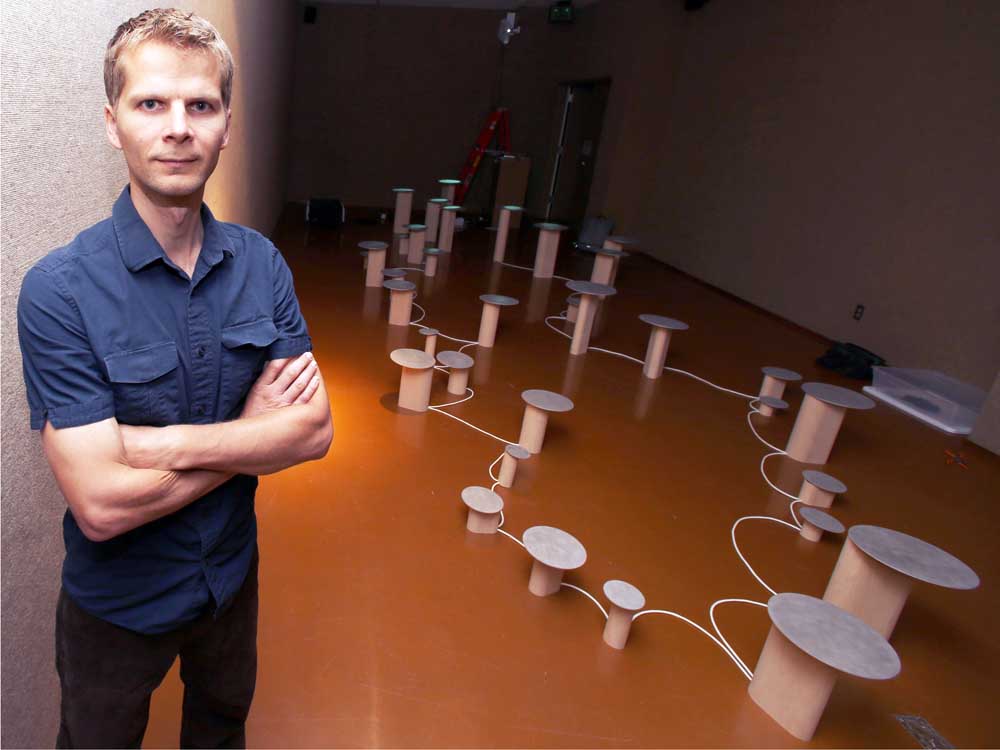Local art galleries participate in 2016 Portland Biennial
Published 12:00 am Thursday, July 14, 2016

- Andy Tullis / The BulletinArtist David Bithell of Ashland, with "Passage," his contribution to the 2016 Portland Biennial. A reception for the show will be held from 5 to 7 p.m. Saturday in The Gallery at Pinckney Center on the COCC campus in Bend.
Thanks to the 2016 Portland Biennial, Central Oregon will host receptions for contemporary artists from opposite ends of the state Saturday.
The ambitious project places a total of 34 Oregon artists at 25 venues in 13 communities across the state, from Ashland to Astoria, Linfield to La Grande. The participating Central Oregon galleries are Art Adventure Gallery in Madras and The Gallery at Pinckney Center in Bend.
The two shows offer Central Oregonians an opportunity to view work they may not have otherwise seen, at least not at a local venue or without a lengthy drive: Art Adventure Gallery is hosting Portland multimedia artist Pat Boas and writer Jon Raymond, and The Gallery at Pinckney Center hosts Ashland’s David Bithell, an artist who incorporates his background in music composition into his installation.
Broad showcase
According to Kris Anderson, chair of the Biennial and a board member of Disjecta Contemporary Art Center in Portland, the Portland Art Museum originally presented the Portland Biennial from 1949 until 2006. Disjecta picked up the baton in 2010, holding exhibits at venues across Portland and taking the last two Biennials to Ashland’s Schneider Museum of Art. This year marks the first time the Biennial has traveled so far and wide.
“We are really excited about this year’s Biennial, because it is what we assume … to be the broadest showcase of Oregon contemporary art, possibly ever,” Anderson said.
The 2016 curator, Michelle Grabner, whose past credits include co-curating the 2014 Whitney Biennial in New York, sought to have artists explore the concept of regionalism in their projects.
“She’s really trying to foster a dialogue and really help different arts communities exchange ideas with each other and (let) different communities gain exposure to different types of contemporary art,” Anderson said. “She deliberately placed artists from east of the Cascades in Portland, and artists from Portland, from Ashland and from the I-5 corridor (in galleries) east of the Cascades.”
‘Passage’
Bithell’s piece is a large installation consisting of sound and light titled “Passage.” Part visual art, computer code and musical instrument, “Passage,” like a lot of his artwork, explores the nexus of music, visual art and performance.
It’s made up of a series of aluminum discs atop resonating chambers of various sizes, “so the size of each of these units is relative to the frequency, so the pitch they resonate at. Just like a vibraphone or a marimba, they have resonators on the bottom that are different sizes,” Bithell explained during a break in installation last week. The chambers range from heights of a couple of inches to 26.
The 36 individual notes are coordinated by computer and able to play a variety of robotic percussion music.
“Passage” can be viewed as an abstract representation of the technology and the interaction between light and sound, Bithell said. On the other hand, it addresses the Biennial theme, too.
“The arrangement and sort of idea behind it, and the title of ‘Passage,’ is meant, a bit, to sort of refer to the idea of moving back and forth between things and stages in life,” Bithell said. Originally from Southern California, Bithell earned a doctorate in music composition at University of California, Berkeley, before settling five years ago in Ashland, where he teaches digital art at Southern Oregon University.
“With regionalism as part of the Biennial, I got to thinking of my personal sort of movement across the country and the recent move of my parents to Bend, and losing the ties of where they were previously, where I grew up in Southern California, losing some of those geographical ties. And so in some way the piece is a reflection of that, so you can see each of the notes as being a location in one’s life, and activity that might move between those locations.”
Connecting points
Portland’s Boas will have two shows running concurrently in the Biennial, which runs through Sept. 18. Along with Madras, her work — paintings, drawings, prints and digital projects that explore reading — will also show at Bush Barn Art Center in Salem. Portland author Jon Raymond and his writings about Portland will also be part of the Madras exhibit.
The geographic distance — connecting artists to communities up to hundreds of miles away — is at the heart of the project.
“With this Biennial, we’re really hoping to get people thinking about Oregon’s art on a truly statewide level, giving art lovers in Portland an opportunity to explore Madras and Clatskanie and art lovers in Bend the chance to experience Pendleton, Ashland or Portland’s scene,” Anderson said. “We think this dialogue will have the same benefits for the artists themselves: We like the idea of broadening and deepening points of connection.”
The show runs through Sept. 18. Anderson and others at Disjecta hope its long duration means artists and nonartists alike will have plenty of time to gas up and go.
“We’re really excited about the road-trip potential of this Biennial,” Anderson said. “It’s a great opportunity this summer to get in the car and drive to communities that you haven’t visited before or that you may not be as familiar with, and see some great contemporary art while you’re doing so.”
(Editor’s note: This story has been modified to include Jon Raymond’s contribution to the Biennial exhibit in Madras.)






